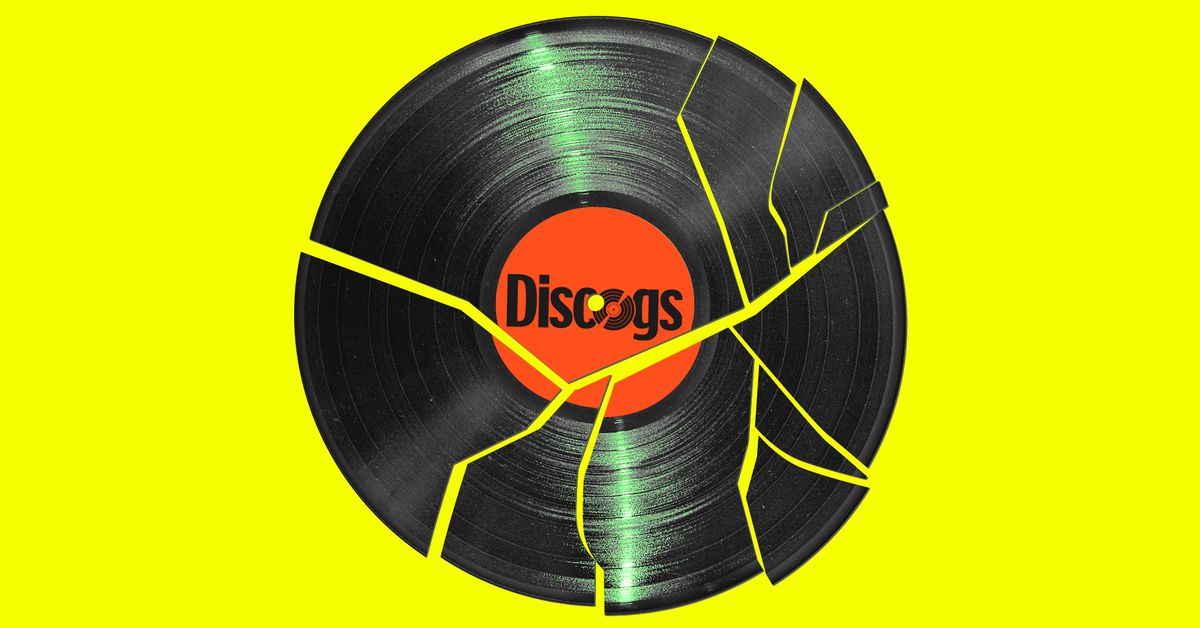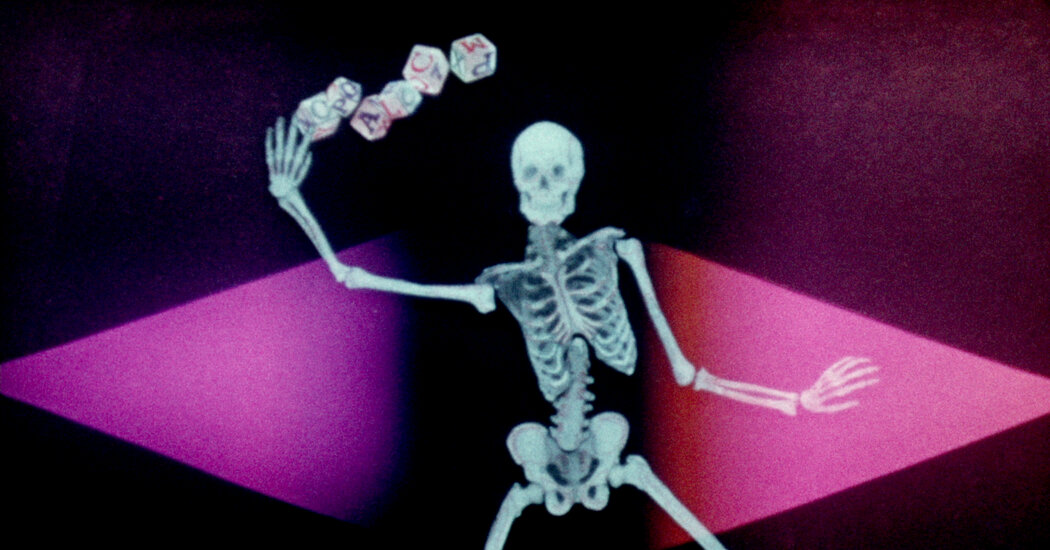If you are a devoted vinyl collector, an obsessive music fan, or — as is often the case — both, Discogs is very nearly a lifestyle. The site has become the internet’s foremost database of recorded music and one of the most extensive marketplaces available for physical music media, with every bit of it generated and offered by users. You can catalog your collection, look up information about even the most obscure artists, cross-check record store prices to see if your local shop has a markup, and purchase records, typically at something close to their “market rate.”
“Some people just buy records for the album art hanging on the wall,” says Doug Martin, who started selling on Discogs in 2020. But the Discogs users were different. “These were real fans listening to real music who cared about the format and the medium. That’s what attracted me in the beginning.”
The site has become a central part of the music internet, surviving through physical music media’s replacement by MP3s and then streaming — and rebounding as interest in vinyl, CDs, and tapes did throughout the 2010s. But sellers who use the platform say the site’s old tech has started to wear on them, and new fees and restrictions have made it harder to do business. Changes within the company are threatening to turn a bastion for vinyl fans, record stores, and anyone who cares about music into just another dysfunctional website — and dismantle a singular record of music history, even if just by pushing the sellers and users who have created that record away.
A fastidiously detailed Wikipedia for music
What was initially conceived of as something of a Wikipedia for recorded music — although, founded in 2000 by Intel programmer Kevin Lewandowski, it predates the encyclopedia site by a few months — hasn’t changed a great deal since its conception, besides the introduction of the marketplace in the mid-aughts. Discogs is a fairly clunky, definitely old-fashioned website devoted to even older technology: a vestige of an earlier, more idyllic internet that has spent the last decade walking the record-needle-thin line between 2020s algorithmically driven tech monolith and niche unprofitable obscurity.
A big part of its ability to walk that line is the passion of its user base. Sellers have to submit a record’s information if it’s not already in the database in order to sell it — that’s how the database has become so complete. And many entries, even for deep obscurities, are fastidious: album covers and liner notes are scanned for inclusion and album credits are fleshed out with hyperlinks that are almost more useful and thorough than the Wikipedia equivalent, plus reviews by devotees. There is even a lively forum where all of these details get litigated. It is an insular community in many ways. But it is also, and has always been, a money-making endeavor for both Discogs and the sellers who use it.
Discogs is now the source of many people’s full-time employment. A European Discogs seller, who has been on the platform since 2008 and requested anonymity for fear of retribution by the company, says he does 80 percent of his business on the platform. He does not operate a brick-and-mortar storefront but has four employees and nets around €20,000 a month on Discogs. According to him, his sales have shrunk by half over the past year, and he’s in the process of building his own site to try to move away from the platform.
“I’ve made my living with this company for the past decade,” says a Connecticut seller who also does the majority of his business on Discogs and requested anonymity for the same reasons. “It’s just the frustration that you have no control over what they’re doing, and it doesn’t even make any sense.” The vinyl renaissance has occurred in tandem with the growth of Discogs, making the site fairly integrated into any record business — regardless of whether a business has a brick-and-mortar storefront. A major change to the site, then, could mean a major shift in the record market as a whole.
Underlying the sellers’ complaints is a kind of dismay, the feeling that what had previously been a safe haven for nerds to buy and sell $2 records is being threatened — that one more corner of the internet that wasn’t yet a glossy behemoth designed to subsume and capitalize on your personal information was about to collapse.
“When you get any kind of community built around a business, and you tweak that a little bit, you’re gonna make a lot of people upset,” says Martin. “This is their Discogs, they built it.”
The problems started in earnest when the company raised its fee from 8 to 9 percent on May 22nd of this year, and — crucially — started charging that same fee on shipping costs for the first time, an issue considering how international the record market is. One of the beauties of Discogs had previously been finding and purchasing rarities from sellers in Japan or Germany; the most expensive record I’ve ever purchased, for example, was a copy of Cannonball Adderley’s debut album from a seller in Switzerland. Now, the site is taking considerably larger slices of those kinds of sales. (Discogs declined to comment for this story.)
You’ll find details on just about every release of every album on Discogs. This entry for a Japanese pressing of Thelonious Monk in Italy includes photos of the record jacket and both sides of the vinyl.
To make up for the lost revenue, Discogs suggested sellers use a tool it had created to raise the prices of all of their inventory by a percentage; another Discogs email to sellers suggested they offer free shipping to avoid the fee, without accounting for the fact that the seller would then be either covering that cost out of pocket or integrating it into the price of the record — which would, of course, result in the same amount of money going to Discogs. Essentially, sellers were told to raise their prices and / or offer free shipping — two options that threaten their bottom lines. “Their communication, too — it’s like, ‘I said what I said, and we’re done,’” says Martin. “Well, you’re really not, because we all have to live with this and so do you.”
The tension between Discogs’ old-internet charm and its attempts at growth came to a head earlier this summer around a since-deleted viral Twitter thread by artist and label head Mike Simonetti lamenting “the fall of discogs.” Simonetti sounded the alarm about increasing fees and subsequently increasing prices, a growing influx of scammers, rising shipping costs, and the dysfunction of the website itself, among other issues.
“We had kind of thought Discogs was on our side as sellers,” says Gene Melkisethian, who runs Joint Custody, a record store in Washington, DC, and sells on Discogs. “But when they started charging fees on shipping, it just felt really punitive.”
“In their communication, it was beyond insulting the way they framed it. Like, ‘Oh, you can just not charge for shipping,’” says the Connecticut seller. “The sudden fee increase was a huge, huge blow to a lot of people.”
The fee increase arrived shortly before USPS raised the price of its Media Mail service (the lower rates at which anyone can send media products like books, music, and movies) by an average of 7 percent — and a year after the site had switched all its transactions to PayPal, which charges its own fees on each transaction, ones that are higher on international purchases. PayPal also requires that every shipment has a tracking number, which can be a significant extra expense for international sales.
The changes also arrived at the tail end of a phenomenon alluded to in the same original thread. The pandemic had created something of a record sales bubble: people who were already vinyl aficionados were stuck at home with their record players, stimulus checks, and nothing to spend them on besides survival and things you could do at home — like listen to music. Melkisethian says his sales actually grew during the pandemic in spite of the fact that his brick-and-mortar sales disappeared. According to him, the boom inflated record prices; now, with the higher fees Discogs is imposing, a sales decline that was almost inevitable post-lockdown has become steeper.
“They’re under the impression that they’re the only game in town.”
Even with all of those increasing costs, Discogs is still less expensive (albeit now only slightly) than alternatives like eBay or Amazon. But those alternatives, being considerably larger and more mainstream, offer a much broader base of potential buyers as well as a more solid infrastructure and support system.
“eBay has much more of a user base, so for the little bit of extra cost it’s a no brainer,” says Martin, who says that, for him, eBay’s fees are usually around 1 percent higher than Discogs’. “It’s probably double [the business] I do on Discogs, and that’s only grown since they raised the fees.” He sells primarily new vinyl and uses Amazon, Walmart, eBay, and Discogs, along with his own website, apocalypsevinyl.com. With the new fees and the competitiveness of the Discogs market, the platform is becoming less and less useful as a selling channel.
“They’re under the impression that they’re the only game in town,” says the Connecticut seller of Discogs. “The fees were relatively low, but now that they’re higher, there doesn’t seem to be a reason to use that anymore.” He’s been selling on Discogs since 2009; since the recent changes, he’s lowered his prices to offset the higher shipping costs and was compelled to institute an order minimum — a major shift for a marketplace that had done considerable business in selling records under $10 and even under $5.
Discogs attributed the need to raise fees to its “significant investments in recent years to ensure compliance with various regulatory programs, including tax support and privacy protection.” The company said the change would allow it to “continue to devote resources to maintaining the Discogs Marketplace and develop better tools for collecting, selling, and enjoying music.”
Many sellers who spoke with The Verge speculated, in line with the viral thread, that the company was trying to pump up its valuation for a potential sale. All of them, though, had the sense that Discogs was trying to increase its profit margins without necessarily offering any improvements to its product in return.
Discogs’ marketplace page showing copies of Olivia Rodrigo’s Guts for sale. The prices are generally higher than buying the album elsewhere.
“It just seems like they’re actively trying to stop sales,” says the Connecticut seller. “You can raise your fees, but maybe you could do some promotions, coupon codes, sales — something that offsets the shift. Sellers can do it on their own, but that’s going to require them to lower their prices — it’s going to be a race to the bottom. If you were trying to ruin a sales forum, this is how you’d do it.”
Discogs did have a sale in late August, but it featured just 11 of the site’s largest stores. “When I first saw it, I thought, maybe they’ll be randomly promoting stores or the best products,” says Martin. “I don’t know a big sale that most people are not part of that you promote to further depress our prices is the right direction.”
The website itself is a frequent source of complaints, as is the lack of support. (My query for a press contact was sent on July 25th, for example; I received a response on August 23rd.) “I guess the most apparent thing has been the lack of updates, or any positive progress in the operation of a website,” says Melkisethian, who has been selling on Discogs since 2011. “It was a little bit quaint back then, but it has not improved in any way. It’s actually only gotten worse, which is kind of funny — but knowing how much money I’ve given them and other people give them, it’s like, who’s steering the ship?”
Discogs is in the process of rolling out a redesign, one that — to look at the forums at least — doesn’t have many fans among the Discogs lifers but is definitely sleeker-looking. According to the sellers who spoke with The Verge, bugs abound: the European seller, for example, had just been dealing with an issue with the platform’s refund button. “Discogs said it was PayPal’s fault, and PayPal said it was Discogs’ fault,” he says. “It caused stress for the buyers, and so I had to do direct refunds — which meant I was refunding not just what I made but Discogs’ and PayPal’s commissions as well, effectively losing money on the refund.” Melkisethian, speaking a month later, had just noticed a shift in the way shipments are processed that required manually entering information in steps that used to be automated.
Besides the baseline functionality of the site, there are other improvements that could bring Discogs closer in line with its competitors. “There are other seller tools and seller initiatives that we’ve been asking for for years that have never been done — like any kind of tie-in with Google, any kind of integration with social media, the kinds of things basically other platform has,” says Martin.
The database is another aspect of the site that could be threatened by the fee increases. If sellers and buyers move elsewhere, that database will likely become less exhaustive. “Ever since the price increases, I’ve noticed that less and less new albums are being added to the database,” says Martin. “When we get new stock in, we have to match it up with a UPC on Discogs and we’re noticing it’s not there as often as it used to be.”
A beloved internet sanctuary gets bled for profit to the detriment of its functionality — by 2023, it’s become just about the most familiar story online. Discogs, hopefully, will not become the latest in a long line of formerly useful sites; for the moment, though, sellers feel alienated by the small company they once viewed as an ally in an optimistic mission to share knowledge about music.
“There are a lot of good things about Discogs, and I think Discogs is worth fighting for and saving,” says Melkisethian. “I think it’s still more of a good than a bad. But the people at Discogs need to be aware of what makes it special — to think about the little guys with the records.”












